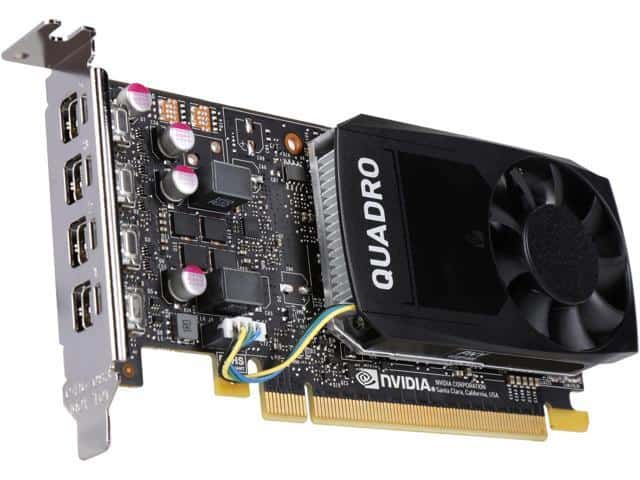amazon NVIDIA Quadro P1000 reviews
Introducing the NVIDIA Quadro P1000 card
NVIDIA Quadro P1000 is a professional graphics card with NVIDIA’s Pascal GPU architecture. Compared to its mid-range brother Quadro P4000, the Quadro P1000 is truly impressive at its price. Quadro P1000 is a card series that uses power directly from the PCI slot, so it is suitable for workstations with limited power, space and PCI slots. Although the Quadro P1000 cannot meet some of the demands that require high-end cards such as Quadro P4000, P5000 and P6000, however, the P1000 will be able to handle most use cases.
The Quadro P1000 is equipped with a 640 CUDA GPU Pascal GPU, 4GB GDDR5 on memory and advanced display technologies, all packed inside a compact size. In addition, the Quadro P1000 supports up to four 4K monitors with an original resolution of 4096×2160 (60Hz) and does not require any additional power connectors, since its maximum consumption is only 47W – less half compared to the Quadro P4000.
Quadro P1000 product image
Quadro P1000 case – Compared to the previous generation Quadro cards, the P1000 case is more compact in size, designed with the unique colors of NVIDIA.
In addition to the colorful outer shell, the inside also adds a tougher black shell.
This is what is packed in the NVIDIA Quadro P1000 card box – Includes manuals, DVDs containing drivers, P1000 cards, 4 cables that convert from Mini Display Port to Display Port and include low-profile blocking for enclosures The machine has limited space (eg 1U, 2U servers).
The bottom as well as the top are simply designed, without P1000, we can be confused with the Quadro P600 / Quadro P400 card.
NVIDIA has equipped the Quadro P1000 with 4 mini DisplayPort ports and is connected via PCIe 3.0 x16 interface.
Here are the top 4 transitions from mini Display Port to Display Port. Consistent with the connection standards of new generation LCD monitors. If you are using an older generation monitor with DVI / HDMI only, you need to have a transfer cable from Display Port / mini Display Port to DVI / HDMI.
At only 145mm in length, the Quadro P1000 also has a single slot cooling solution.
The back of the card is information about the product model and serial number
where can you get a NVIDIA Quadro P1000 online
PNY NVIDIA Quadro P1000 Professional Graphics Board (VCQP1000-PB): Buy it now
Specifications of NVIDIA Quadro P1000
Original GPU memory: 4GB GDDR5
Memory interface: 128-bit
Memory bandwidth: Up to 82GB / s
Core NVIDIA CUDA: 640
System interface: PCI Express 3.0 x16
Maximum power consumption: 47 W
Thermal solution is operating.
Size: 2.713 “H x 5.7” L, one slot, low display
Connectors: 4x mDP 1.4
Maximum simultaneous display: 4 direct, 4 DP 1.4
Multi-line screen resolution: 4x 4096×2160 @ 60Hz / 4x 5120×2880 @ 60Hz
Graphics API: Shader Model 5.1, OpenGL 4.53, DirectX 12.04, Vulkan 1.03
Calculation API: CUDA, DirectCompute, OpenCL
Quadro P1000 performance
To evaluate the NVIDIA Quadro P1000, we tested the card on the HP Z640 workstation and ran some graphics benchmarks to evaluate performance when compared to the most similar GPU in the lab, which is NVIDIA Quadro M2000 ( Maxwell architecture). Although segmented and with different architectures, they are similar in many ways: both cards have 4GB GDDR5 in GPU memory and 128-bit communication memory and utilize PCI Express 3.0 x16 slots. Although the Quadro M2000 is introduced with bandwidth of up to 106GB / s (compared to 82GB / s), the P1000 is half the size and power consumption is the same. To achieve this, we will use a benchmark to investigate some aspects of the ArcGIS program; however, we are most interested in the average of runtime, average frames per second, and minimum frames per second.
Looking at the runtime, the Quadro P1000 measured 6,412 seconds, only slightly higher than the Quadro M2000 (6,262 seconds). In the average FPS, P1000 averaged 342.25 FPS while the minimum FPS reached 187.16 FPS, better than the Quadro M2000, reaching 273.51 FPS and 160.51 FPS respectively.
The next standard is SPECviewperf 12, a worldwide standard for measuring graphics performance based on professional applications. SPECviewperf runs 8 standards that it calls Viewsets, all representing the content and manipulation of graphics from real applications. These viewsets include CATIA, Creo, Energy, Maya, Mecial, Showcase, Siemens NX, and Solidworks. Here, the NVIDIA P1000 has reached a significant amount, with the same results with the Quadro M2000. It performed better in half of the tests (Energy, Maya, Mecial, and Solidworks), but not much; The same is true for Quadro M2000.
Conclude
Overall, the Quadro P1000 is a solid addition to NVIDIA’s professional graphics card portfolio. Quadro P1000 uses a good CUDA Pascal GPU and 4GB GDDR5 processor while supporting NVIDIA Mosaic, HDCP 2.2, and NVIDIA Iray and MentalRay technologies.
Remember “Not evaluate through the appearance” of the Quadro P1000 card, this 5.7 inch card provides the same performance as the card in the higher segment. This has been clearly demonstrated in our tests when comparing it to the Quadro M2000, which has a full size longer than the Quadro P1000. In these tests, NVIDIA’s new Quadro card had better performance than the Quadro M2000, especially in our ArcGIS standards, impressed by the difference in price and segmentation, because Quadro P1000 has a low price about $ 100 more than the old generation NVIDIA card in the higher segment.
